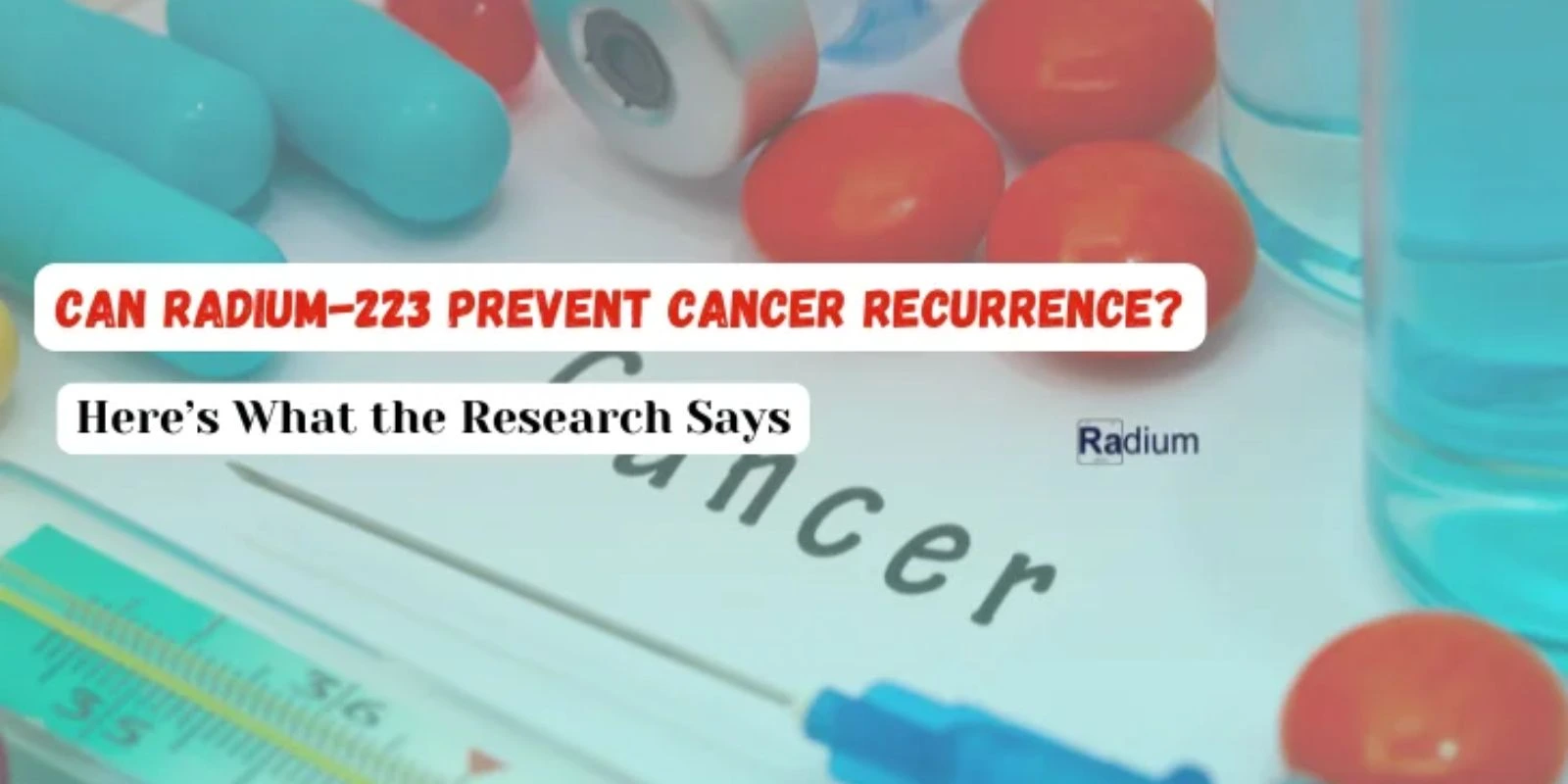
Can Radium 223 Prevent Cancer Recurrence? Here’s What the Research Says
When it comes to cancer treatment, many patients ask the same question: Even for cancers that can be treated, like colon and rectal cancers, can the treatment stop cancer from recurring? In cases of late-stage prostate cancer or where the cancer has reached the bone, Radium-223 is one treatment that seems to work for many men. This radioactive substance is in an emerging area in oncology and holds a light to people fighting tough cancer wars. But does it actually help in avoiding the return of cancer? According to the research done on the topic, how effective is it in bringing about long-term remission?
In this blog, you will learn about the mechanics of using Radium 223 in cancer treatment, the available studies on its application, and its potential to become a truly groundbreaking method for preventing cancer from recurring. This paper will discuss the benefits and drawbacks of the therapy, with special reference to the extent of influence of the therapy on oncology.
Why Radium 223 and How Does it Work?
Radium 223 is a radiopharmaceutical used to treat hormone-refractory mCRPC that has spread to the bones. The treatment has delivered good result in relation to reduction of pain and again, the quality and chances of survival for men with Terminal cancer. This is due to the fact that it imitates the form of calcium and since the cancer cells are in the bones this piece of equipment will pin point the bones where the cancer cells are most abundant and irradiate the required area. Radium-223 is selective and target bone metastases unlike conventional radiotherapies that may affect the general healthy tissues.
The idea behind its use is simple: prioritize the cancer cells in the bones in the sense that they have not developed ways of how to proliferate. For this reason, Radium-223 has emerged as quite a useful asset in oncology particularly in patients diagnosed with castration-resistant prostate cancer (CRPC).
Can Radium 223 Stop Cancer From Coming Back?
One of the most common questions that patients ask their physicians when commencing on any form of cancer treatment is whether this treatment will be effective in eradicating the possibility of the cancer recurring. Currently, investigations of this agent in connection with the prevention of cancer relapse are quite promising, yet inconclusive.
Radium 223 is not a cure for prostate cancer; it is only used to treat the bone specialist. However, its use in metastatic cancer is one that contributes to the halting or reversal of this condition making it an important substance in cancer management. Clinical investigations have revealed that patients receiving Radium-223 therapy have been proved to record low instances of tumor recurrence in the bones than most treatments.
Also, further studies are being conducted to analyze the ability of Radium-223 to be used together with hormone treatment or chemotherapy in order to raise survival rates and minimize the frequency of repetition.
Mechanism of Action
The exact process through which Ra-223 was found to operate entails the radioactive release of alpha particles that induce double-strand DNA breaks in the neighboring viable cells. This causes cell death particularly to the fast multiplying cancerous cells of the body as they lack the normal controls and their division is unregulated. The short range of alpha particles reduces the damage that can be done to surrounding healthy tissue and therefore Ra-223 is a targeted therapy.
How Effective is Radium 223 in Oncology?
When compared to other cancer treatments Radium-223 is one of the newest and is believed to be more effective when considering far advanced prostate cancer. Not only does it can effectively decrease the patient’s pain when the cancer has occurred in the bones, but it also contributes to the patient’s quality of life. This makes it an important weapon in fight against this malicious disease of cancer.
But, the question of total prevention still remains unanswered. Radium-223 is useful in the treatment of cancer though it doesn’t rule out the chance of the disease re-emerging. That is why scientists pay great attention to the analysis of its effects on the rates of survival and the absence of recurrences.
What Does the Research Say?
A number of researches have underscored the importance of Radium 223 in the improvement of the longevity of the man with advanced prostate cancer. In a large study named ALSYMPCA trial, patient lived slightly longer if they received Radium-223 agent. First, patients’ survival rate was enhanced, and second, quality of life was improved since the treatment relieved pain.
However, these studies also stress that Radium 223 should not be considered a stand alone treatment. It is most effective when used together with other cancer treatments and though slows the development of the cancer in the bone, it does not halt the development of the cancer in other parts of the body.
Side Effects and Limitations of Radium 223
As is expected of any cancer treatment, Radium 223 has its side effects. Feeling sick or vomiting, having more frequent bowel movements, and having less blood cells than normal are usual side effects. Nonetheless, it escalates and is less toxic than chemotherapy and other conventional treatments such as Radium-223.
Another weakness of Radium-223 is that it has intended use only for the treatment of bone metastases. It doesn’t actually work on cancer that has metastasize to other organs like the liver or the lungs. This means that even though it works wonders for men with prostate cancer that has spread to the bones, it may not work as well for other types of metastatic cancer.
Research Overview
Efficacy and Safety
Inclusion Criteria Participants should be more than 18 years of age with histological confirmed bone metastases from carcinomas, preferably with a life expectancy of over six months, an ECOG performance status of 0 to 2 and a serum creatinine level within 1.5 times of the institutional upper limit of normal. Exclusion Criteria Participants with a previous history of radiotherapy to the target site, or planned concurrent or subsequent therapy, including The ALSYMPCA study afforded evidence of a survival advantage in patients who received Ra-223 as opposed to placebo. In patients who received Ra-223 the overall survival was 14 months as compared to 11.2 months of the control group. However, it should be noted that the applied treatment was pretty much tolerated without many adverse effects being reported.
In a phase II expanded access program, Ra-223 was given to the patients with symptomatic mCRPC who had not yet had chemotherapy. Morbidity and mortality studies showed that 73% of patients had improved outlook and median overall survival time was 17 months.
Quality of Life Considerations
Quality of life (QOL) outcome research related to Ra-223 treatment has also been the subject of other recent investigations. For example, in the RAPSON trial, Ra-223 before chemotherapy scenario showed better compliance to QOL-related indices than with the sequence of chemotherapy followed by Ra-223. According to patients surveyed, the use of Ra-223 first improved tolerability and had less impact on pain in performing daily activities.
Recurrence Prevention
Although results with Ra-223 have been favorable in terms of extending survival and enhancing QOL, its use in the management of cancer recurrence is not as well defined. According to some investigators, initiation of Ra-223 treatment appears to decrease the likelihood of recurrence because existing bone metastases may be managed more efficiently. Yet, limited clinical trial and data are available to confirm the role of adjuvant radiation therapy at preventing disease recurrence on its own.
Is Radium-223 the Key to Preventing Cancer Recurrence?
Radium-223 is a highly innovative therapy in oncology; optimal application of this agent is to patients with aggressive metastatic castration-resistant prostate cancer that affects the bone tissue. It has some advantages, for example: relief from pain, better quality of life and longer survival of patients. But the effect of the drug in preventing cancer from recurring has not been fully determined.
Still, Radium-223 has been proven to slow down the progression of cancer to the bone; however, this does not make a recurrence impossible. That is why this therapy is frequently used together with other types of therapy to create an integrated approach. The latter is still important to enable doctors isolate this cancer and treat with elements such as Radium-223 before it has progressed a lot to the other parts.
In the sphere of oncology, Radium 223 is one of the breakthroughs that has more benefits for men with crpc. Nevertheless, further research need to be carried out to ascertain whether it fully prevent the recurrence of the problems.
Conclusion
The approval of Radium 223 is a major step forward in the therapeutic management of mCRPC. Despite establishing its effectiveness in increasing patient’s survival as well as enhancing their quality of life in case of bone metastases, it is yet unknown how it can protect from cancer relapse. The existing literature suggests that early intervention may provide some sort of protective effect against the risk of relapse, yet, more methodologically sound research is required to set the truly clear and effective course of action.
Frequently Asked Questions
Que: Can Radium 223 prevent cancer recurrence?
Ans: Radium 223 is useful in limiting the extent of cancer in bones and can lower the chances of cancer arising again in other bones but it is not a cure.
Que: How long do the effects of Radium-223 last?
Ans: Some researches have provided evidence that Radium-223 can increase the survival time by several months and reduce pain, but data on the impact on recurrence are still insufficient.
Que: Is Radium-223 a cure for prostate cancer?
Ans: No, Radium-223 is not a cure. It aids in controlling the symptoms and even the progression of the disease; specifically, it has a role on musculoskeletal progression.
Que: What are the side effects of Radium-223?
Ans: Possible side effects: nausea, diarrhoea, and decrease in red and white blood cells. In comparison to other treatments Radium-223 has mild side effects.
Que: Can Radium-223 be combined with other treatments?
Ans: Yes, Radium-223 is employed together with hormone therapy or chemotherapy to enhance the efficacy of therapies.
Disclaimer
The content in this blog serves educational purposes exclusively and should not be construed as medical advice. It is crucial to seek guidance from a qualified healthcare professional for precise diagnosis and treatment options related to prostate cancer or any other medical condition.
